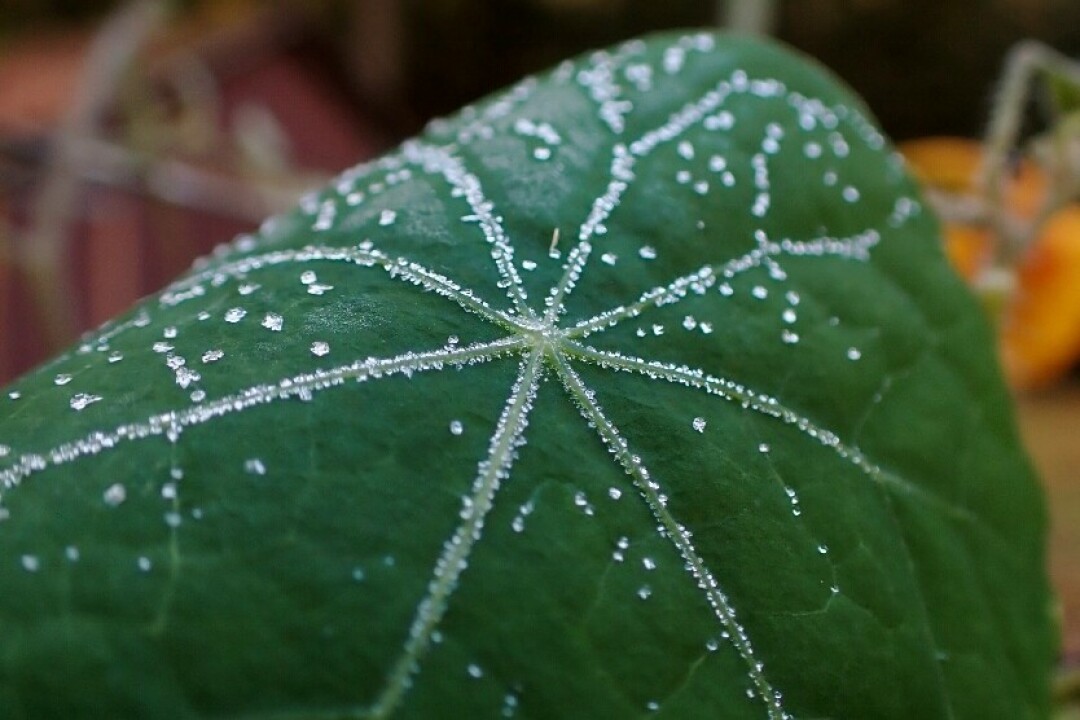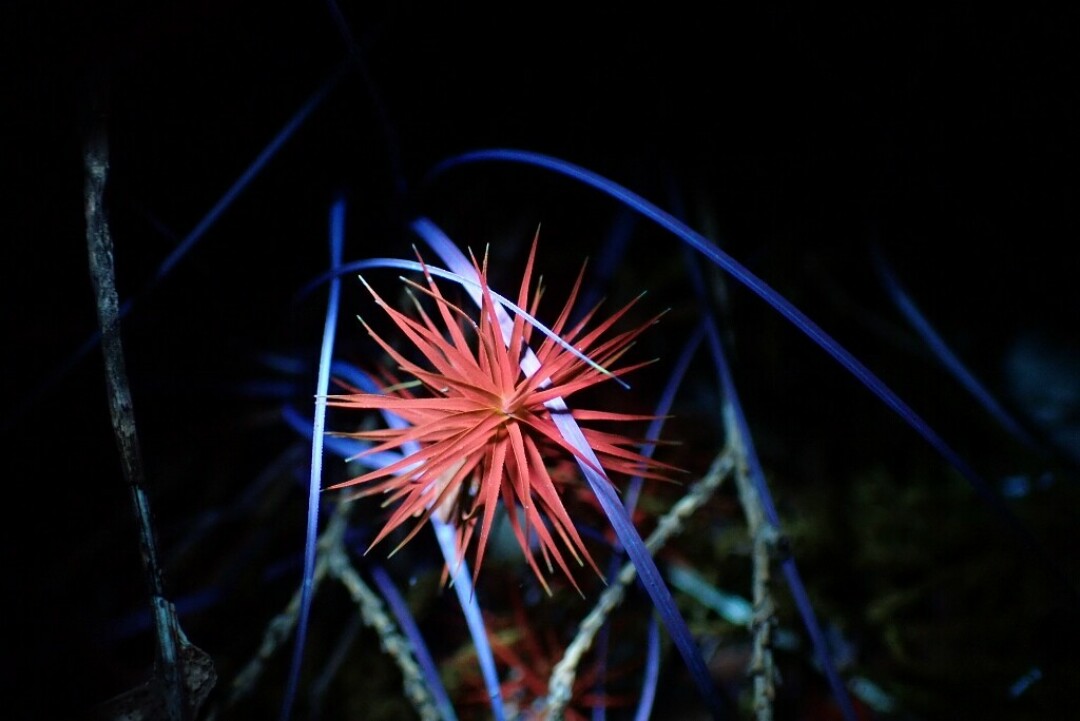Awe walks

Frost radiates out along the veins of a nasturtium leaf. Photos by Emily Stone.
Frost came first to the nasturtium leaves in my garden. When I stepped outside at dawn, the radiating arms and web-like patterns of their leaf veins were all highlighted by a dusting of diamonds.
I grabbed my camera, and tried to capture the beauty before my fingers went numb. When I finally ducked back inside the warm house for coffee, I felt like my chest had expanded.
That night, I took my camera and my UV flashlight out for a walk. A dying iris leaf on the lakeshore shone with the yellow of a fresh Number 2 pencil, and melted frost sparkled like fairy dust.
One spike of moss glowed with a vibrant red, while another’s leaves were curly and green. Among the soft throngs of mosses, my beam of light caught the white body of a tiny larva, and it glowed eerily.
The closer I looked at the mossy bank of my driveway, the more I saw. And the effect seemed infinite.
Using the UV flashlight revealed one new way of seeing; and zooming in with the super-macro setting of my camera opened up a new world, too.
There was more to see here than I could possibly know. All I would have to do to explore is keep looking in new ways. I felt like I’d discovered a whole new ecosystem – a whole new universe – in an area the size of my own shadow.
I don’t even know how long I was out there. My fingers and toes got cold, and the flashlight battery grew weak.
When scientists look closely at things in a new light, they make even more amazing observations. A team of professors and students at Northland College, led by Dr. Paula Anich, recently revealed that platypuses fluoresce brilliantly in shades of green and blue. Their paper was published in the journal Mammalia. Paula said, “For me, this reinforces how much is yet to be discovered, and it reinforces how little humans know about certain times of day, and the ways that animals perceive things. It makes me think that we are standing on the edge of big new leaps into how animals perceive things, especially at night.”
Wow.
 Something as simple and common as moss can elicit feelings of awe, especially when we look closer, or in a new light (this photo was taken with UV light).
Something as simple and common as moss can elicit feelings of awe, especially when we look closer, or in a new light (this photo was taken with UV light).
What Paula and her students probably experienced while looking at platypuses in the basement of the Field Museum, and what I experienced out there – in my own yard – was awe.
People also do research about awe. Did you know that? I didn’t, until recently.
According to the science, there are two components of an “awe experience.”
First, you need to perceive that you’ve encountered something vast. That vastness could be represented by something’s number, size, scope or complexity.
Second, you need to feel like your brain must expand in order to understand that vastness.
For many people, art and music trigger these feelings. For me, it’s moss, or frost on leaf veins, or a fluorescing platypus, or a thousand other aspects of nature.
I feel pretty fortunate that I’m able to experience awe so easily and so frequently, because feeling awe makes us feel better.
I can’t even count the number of times I’ve started a hike feeling gloomy, stressed out, stiff, and disenchanted with the world, and have come home with a new sense of purpose and well-being after having experienced awe.
This, too, is described in the research. Experiencing awe brings us into the present moment, which changes our perception of time: it slows down. We feel like we have more time. And isn’t that what many of us want most?
That perception of extra time has been shown to make people more patient and more willing to help others.
There are other positive outcomes, too. Feeling awe increases life satisfaction, generosity and humility; decreases aggression; and improves the way we perceive our bodies – and our fellow humans.
Researchers at the UC San Francisco Memory and Aging Center wanted to find out if feeling awe could improve brain health in older adults, so they designed a simple study. The participants were asked to go on a 15-minute walk at least once a week.
Half of the group was given a little lecture about the nature of awe, and were encouraged to try and experience it during their walks. The control group just walked. They all took selfies during each outing.
During the course of the study, the control group actually took more walks (possibly because they thought the study was about exercise) but experienced none of the positive outcomes of the awe group. They mostly reported focusing inward, on things like their to-do lists.
Those who were told to focus on awe reported that they felt more positive emotions such as compassion and gratitude in their daily lives, and less stress. Their attention shifted outward.
In parallel, their faces took up less of each photo, with the landscape around them becoming more prominent, and their smiles took up more of their faces, too. These effects grew stronger the longer they practiced experiencing awe.
So, you’ve just been given your little lecture about the nature of awe. Now, I think it’s time to head outside, don’t you? And if you happen to take a selfie, or just a pretty photo, while you’re out there, feel free to share it with me through email, or the Cable Natural History Museum’s social media accounts, or #awewalk.

The selfies of people who go on frequent “awe walks” end up showing bigger smiles and bigger landscapes. This seems to be a reflection of how their emotions change in response to feeling awe. Selfie, by Emily Stone.
Emily’s award-winning second book, Natural Connections: Dreaming of an Elfin Skimmer, is now available to purchase at cablemuseum.org/books. Or order it from our friends at redberybooks.com to receive free shipping! For more than 50 years, the Cable Natural History Museum has served to connect you to the Northwoods. The Museum is now open with its Mysteries of the Night exhibit.
Connect with us on Facebook, Instagram, YouTube, and cablemuseum.org to keep track of our latest adventures in learning.
